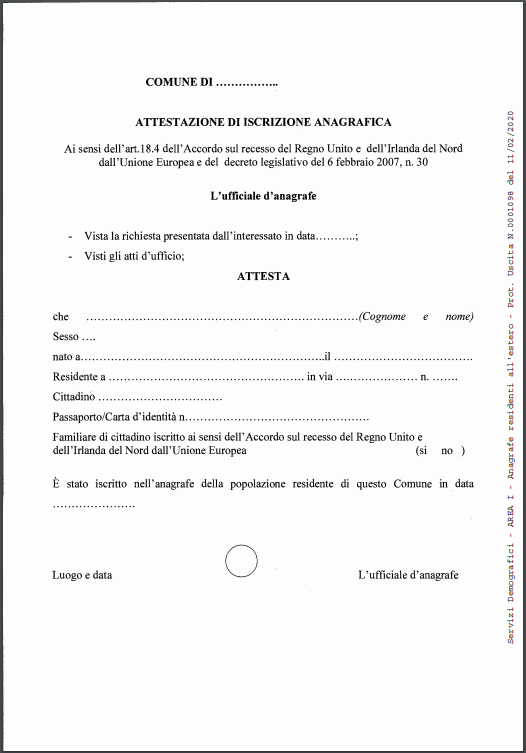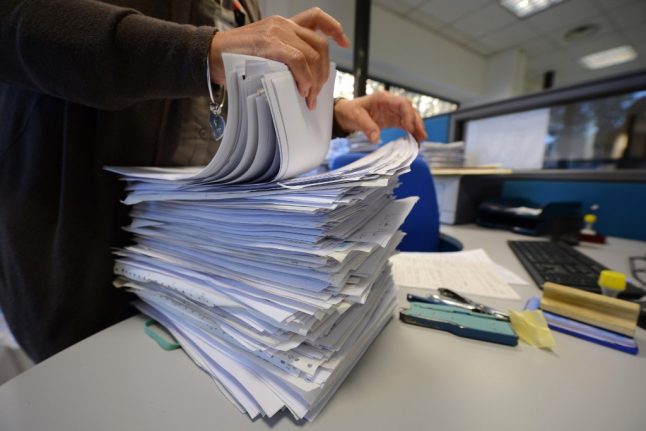It is a legal requirement to register your residency in Italy for those wishing to stay for longer than 90 days. If you are moving to Italy before December 31st or you haven’t yet registered we strongly recommend that you do so before the end of the year.
READ ALSO: Brexit: How are Brits' rights to travel and move to Italy changing?
If you are lawfully living in Italy by the end of this year, your rights will be protected by the Withdrawal Agreement. This extends to your close family members.
By registering your residency now, you will have evidence of these rights. So make sure you register your residency as soon as possible.
Here’s how to register:
1. Go to your nearest town hall, called the comune or municipio. There you will find the registration office, called the anagrafe. Some town halls are only meeting the public through appointments online so check what yours is offering.
2. Download a registration form from the town hall’s website. You will need to complete it and bring it with you.
3. You’ll need a codice fiscale – a personalised tax number – before you apply for residency. You can get this from the Agenzia delle Entrate, or tax office.
READ ALSO: Codice fiscale: How to get your Italian tax code
4. You’ll also need evidence that confirms you are lawfully living in Italy. For example:
- If you’re a worker you’ll need to prove it through a work contract.
- If you are self-employed, take along your Italian VAT number (called a partita IVA in Italian).
- If you are a student, you should take along evidence of your course enrolment. You will also need to show you can support yourself financially and that you have some kind of healthcare cover.
- If you are retired or not working, you will need to show a minimum income of approximately 6,000 euros a year – for example with a bank statement or a self-declaration of your funds. You will also need to provide evidence of healthcare cover.
Check the exact requirements from your local town hall.
5. All applicants will need to provide an original and valid UK passport as an identity document.
6. And lastly, you will probably need to show some evidence of where you live, e.g. a rental agreement. Check with your town hall first what they require.
7. You should expect to pay a small fee in the form of ‘tax stamps’ or bolli. You can purchase these from many shops.
Make sure to call the municipality or check their website for a full list of required documents before you apply.
What happens when you apply?
When you apply, you will receive a receipt of your application. Your date of residency will start from when you submitted your application.
Your local town hall then has 45 days to consider your request. The local police will visit your flat or house to verify that you live there.
Once you hear that your application has been successful, you have the right to obtain a residency certificate called an ‘Attestazione di iscrizione anagrafica’ or ‘Attestazione di regolare soggiorno cittadini UE’.
It should refer to the following law – Decreto legislativo 6/2/2007, n. 30 – because that’s the law it is issued under. So you need to check it does.
READ ALSO:
- Five key things to know about applying for residency in the EU
- How can British second-home owners spend more than 90 days in Italy after Brexit?
- What are the differences between moving to Italy before or after December 31st?
If you haven’t heard anything from your town hall after 45 days, get in touch with them to check the progress of your application.
It’s worth knowing that you may also be able to apply for residency via registered mail, email, fax or electronically. Check your local town hall website to see what services they offer.
If you have lived in Italy for five continuous years you now have the right to obtain a permanent residency document called an ‘attestazione di soggiorno permanente UE’. Ask your local town hall for more details.
READ ALSO: Why UK citizens may face problems proving they have permanent Italian residence
Once you’re registered you now have the right to obtain a second certificate which further evidences your rights in Italy.
This one is called an ‘Attestazione di iscrizione anagrafica’ issued under the Withdrawal Agreement.

If you want to know more about registering for residency as well as your rights under the Withdrawal Agreement, see the UK government's Living in Italy guide.
And if you need help registering, you can get in touch with the International Organization for Migration by calling this number: 800 684 884.
Remember – if you’re planning to settle in Italy, register your residency now.
For more information, see the UK government's guide to help and services in Italy and follow UK in Italy on Facebook or Twitter.



 Please whitelist us to continue reading.
Please whitelist us to continue reading.
Hi, my wife was born England but her birth is registered in Sicily giving her Italian citizenship we believe. Will she be able to move and live there after 31st December 2020 and will I be allowed to go with her as her husband?
I have a second home in Italy (since 2006) and am currently resident in the UK. My son and family live permanently in Italy (he now has permanent resident status). I plan to leave the UK and move to Italy to live. Do I need a visa or can I just apply for temporary (initially) residency on arrival?